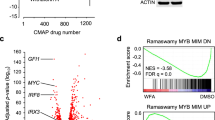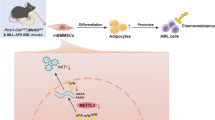Abstract
Despite advances in our understanding of the molecular basis for particular subtypes of acute myeloid leukemia (AML), effective therapy remains a challenge for many individuals suffering from this disease. A significant proportion of both pediatric and adult AML patients cannot be cured and since the upper limits of chemotherapy intensification have been reached, there is an urgent need for novel therapeutic approaches. The transcription factor c-MYB has been shown to play a central role in the development and progression of AML driven by several different oncogenes, including mixed lineage leukemia (MLL)-fusion genes. Here, we have used a c-MYB gene expression signature from MLL-rearranged AML to probe the Connectivity Map database and identified mebendazole as a c-MYB targeting drug. Mebendazole induces c-MYB degradation via the proteasome by interfering with the heat shock protein 70 (HSP70) chaperone system. Transient exposure to mebendazole is sufficient to inhibit colony formation by AML cells, but not normal cord blood-derived cells. Furthermore, mebendazole is effective at impairing AML progression in vivo in mouse xenotransplantation experiments. In the context of widespread human use of mebendazole, our data indicate that mebendazole-induced c-MYB degradation represents a safe and novel therapeutic approach for AML.
This is a preview of subscription content, access via your institution
Access options
Subscribe to this journal
Receive 12 print issues and online access
$259.00 per year
only $21.58 per issue
Buy this article
- Purchase on Springer Link
- Instant access to full article PDF
Prices may be subject to local taxes which are calculated during checkout






Similar content being viewed by others
References
Pui CH, Carroll WL, Meshinchi S, Arceci RJ . Biology, risk stratification, and therapy of pediatric acute leukemias: an update. J Clin Oncol 2011; 29: 551–565.
Bose P, Vachhani P, Cortes JE . Treatment of relapsed/refractory acute myeloid leukemia. Curr Treat Options Oncol 2017; 18: 17.
Tasian SK, Pollard JA, Aplenc R . Molecular therapeutic approaches for pediatric acute myeloid leukemia. Front Oncol 2014; 4: 55.
Khan M, Mansoor AE, Kadia TM . Future prospects of therapeutic clinical trials in acute myeloid leukemia. Future Oncol 2017; 13: 523–535.
Meyer C, Hofmann J, Burmeister T, Groger D, Park TS, Emerenciano M et al. The MLL recombinome of acute leukemias in 2013. Leukemia 2013; 27: 2165–2176.
Krivtsov AV, Armstrong SA . MLL translocations, histone modifications and leukaemia stem-cell development. Nat Rev Cancer 2007; 7: 823–833.
Slany RK . The molecular biology of mixed lineage leukemia. Haematologica 2009; 94: 984–993.
Somervaille TC, Cleary ML . Grist for the MLL: how do MLL oncogenic fusion proteins generate leukemia stem cells? Int J Hematol 2010; 91: 735–741.
Muntean AG, Hess JL . The pathogenesis of mixed-lineage leukemia. Annu Rev Pathol 2012; 7: 283–301.
Neff T, Armstrong SA . Recent progress toward epigenetic therapies: the example of mixed lineage leukemia. Blood 2013; 121: 4847–4853.
Slany RK . The molecular mechanics of mixed lineage leukemia. Oncogene 2016; 35: 5215–5223.
Hess JL, Bittner CB, Zeisig DT, Bach C, Fuchs U, Borkhardt A et al. c-Myb is an essential downstream target for homeobox-mediated transformation of hematopoietic cells. Blood 2006; 108: 297–304.
Somervaille TC, Matheny CJ, Spencer GJ, Iwasaki M, Rinn JL, Witten DM et al. Hierarchical maintenance of MLL myeloid leukemia stem cells employs a transcriptional program shared with embryonic rather than adult stem cells. Cell Stem Cell 2009; 4: 129–140.
Jin S, Zhao H, Yi Y, Nakata Y, Kalota A, Gewirtz AM . c-Myb binds MLL through menin in human leukemia cells and is an important driver of MLL-associated leukemogenesis. J Clin Invest 2010; 120: 593–606.
Zuber J, Rappaport AR, Luo W, Wang E, Chen C, Vaseva AV et al. An integrated approach to dissecting oncogene addiction implicates a Myb-coordinated self-renewal program as essential for leukemia maintenance. Genes Dev 2011; 25: 1628–1640.
Mucenski ML, McLain K, Kier AB, Swerdlow SH, Schreiner CM, Miller TA et al. A functional c-myb gene is required for normal murine fetal hepatic hematopoiesis. Cell 1991; 65: 677–689.
Sumner R, Crawford A, Mucenski M, Frampton J . Initiation of adult myelopoiesis can occur in the absence of c-Myb whereas subsequent development is strictly dependent on the transcription factor. Oncogene 2000; 19: 3335–3342.
Lieu YK, Reddy EP . Conditional c-myb knockout in adult hematopoietic stem cells leads to loss of self-renewal due to impaired proliferation and accelerated differentiation. Proc Natl Acad Sci USA 2009; 106: 21689–21694.
Ramsay RG, Gonda TJ . MYB function in normal and cancer cells. Nat Rev Cancer 2008; 8: 523–534.
Pattabiraman DR, Gonda TJ . Role and potential for therapeutic targeting of MYB in leukemia. Leukemia 2013; 27: 269–277.
Anfossi G, Gewirtz AM, Calabretta B . An oligomer complementary to c-myb-encoded mRNA inhibits proliferation of human myeloid leukemia cell lines. Proc Natl Acad Sci USA 1989; 86: 3379–3383.
Calabretta B, Sims RB, Valtieri M, Caracciolo D, Szczylik C, Venturelli D et al. Normal and leukemic hematopoietic cells manifest differential sensitivity to inhibitory effects of c-myb antisense oligodeoxynucleotides: an in vitro study relevant to bone marrow purging. Proc Natl Acad Sci USA 1991; 88: 2351–2355.
Gonda TJ, Ramsay RG . Directly targeting transcriptional dysregulation in cancer. Nat Rev Cancer 2015; 15: 686–694.
Emambokus N, Vegiopoulos A, Harman B, Jenkinson E, Anderson G, Frampton J . Progression through key stages of haemopoiesis is dependent on distinct threshold levels of c-Myb. EMBO J 2003; 22: 4478–4488.
Pattabiraman DR, McGirr C, Shakhbazov K, Barbier V, Krishnan K, Mukhopadhyay P et al. Interaction of c-Myb with p300 is required for the induction of acute myeloid leukemia (AML) by human AML oncogenes. Blood 2014; 123: 2682–2690.
Uttarkar S, Dasse E, Coulibaly A, Steinmann S, Jakobs A, Schomburg C et al. Targeting acute myeloid leukemia with a small molecule inhibitor of the Myb/p300 interaction. Blood 2016; 127: 1173–1182.
Zhao L, Glazov EA, Pattabiraman DR, Al-Owaidi F, Zhang P, Brown MA et al. Integrated genome-wide chromatin occupancy and expression analyses identify key myeloid pro-differentiation transcription factors repressed by Myb. Nucleic Acids Res 2011; 39: 4664–4679.
Suzuki H, Forrest AR, van Nimwegen E, Daub CO, Balwierz PJ, Irvine KM et al. The transcriptional network that controls growth arrest and differentiation in a human myeloid leukemia cell line. Nat Genet 2009; 41: 553–562.
Horton SJ, Grier DG, McGonigle GJ, Thompson A, Morrow M, De Silva I et al. Continuous MLL-ENL expression is necessary to establish a 'Hox Code' and maintain immortalization of hematopoietic progenitor cells. Cancer Res 2005; 65: 9245–9252.
Horton SJ, Walf-Vorderwulbecke V, Chatters SJ, Sebire NJ, de Boer J, Williams O . Acute myeloid leukemia induced by MLL-ENL is cured by oncogene ablation despite acquisition of complex genetic abnormalities. Blood 2009; 113: 4922–4929.
Walf-Vorderwulbecke V, de Boer J, Horton SJ, van Amerongen R, Proost N, Berns A et al. Frat2 mediates the oncogenic activation of Rac by MLL fusions. Blood 2012; 120: 4819–4828.
Osaki H, Walf-Vorderwulbecke V, Mangolini M, Zhao L, Horton SJ, Morrone G et al. The AAA+ ATPase RUVBL2 is a critical mediator of MLL-AF9 oncogenesis. Leukemia 2013; 27: 1461–1468.
Lamb J, Crawford ED, Peck D, Modell JW, Blat IC, Wrobel MJ et al. The Connectivity Map: using gene-expression signatures to connect small molecules, genes, and disease. Science 2006; 313: 1929–1935.
Williams G . SPIEDw: a searchable platform-independent expression database web tool. BMC Genom 2013; 14: 765.
Corradini F, Cesi V, Bartella V, Pani E, Bussolari R, Candini O et al. Enhanced proliferative potential of hematopoietic cells expressing degradation-resistant c-Myb mutants. J Biol Chem 2005; 280: 30254–30262.
Demaison C, Parsley K, Brouns G, Scherr M, Battmer K, Kinnon C et al. High-level transduction and gene expression in hematopoietic repopulating cells using a human immunodeficiency [correction of imunodeficiency] virus type 1-based lentiviral vector containing an internal spleen focus forming virus promoter. Hum Gene Ther 2002; 13: 803–813.
Minotti AM, Barlow SB, Cabral F . Resistance to antimitotic drugs in Chinese hamster ovary cells correlates with changes in the level of polymerized tubulin. J Biol Chem 1991; 266: 3987–3994.
Lidonnici MR, Corradini F, Waldron T, Bender TP, Calabretta B . Requirement of c-Myb for p210(BCR/ABL)-dependent transformation of hematopoietic progenitors and leukemogenesis. Blood 2008; 111: 4771–4779.
Soliera AR, Lidonnici MR, Ferrari-Amorotti G, Prisco M, Zhang Y, Martinez RV et al. Transcriptional repression of c-Myb and GATA-2 is involved in the biologic effects of C/EBPalpha in p210BCR/ABL-expressing cells. Blood 2008; 112: 1942–1950.
Manzotti G, Mariani SA, Corradini F, Bussolari R, Cesi V, Vergalli J et al. Expression of p89(c-Mybex9b), an alternatively spliced form of c-Myb, is required for proliferation and survival of p210BCR/ABL-expressing cells. Blood Cancer J 2012; 2: e71.
Waldron T, De Dominici M, Soliera AR, Audia A, Iacobucci I, Lonetti A et al. c-Myb and its target Bmi1 are required for p190BCR/ABL leukemogenesis in mouse and human cells. Leukemia 2012; 26: 644–653.
Pantziarka P, Bouche G, Meheus L, Sukhatme V, Sukhatme VP . Repurposing Drugs in Oncology (ReDO)-mebendazole as an anti-cancer agent. Ecancermedicalscience 2014; 8: 443.
Laclette JP, Guerra G, Zetina C . Inhibition of tubulin polymerization by mebendazole. Biochem Biophys Res Commun 1980; 92: 417–423.
Nygren P, Fryknas M, Agerup B, Larsson R . Repositioning of the anthelmintic drug mebendazole for the treatment for colon cancer. J Cancer Res Clin Oncol 2013; 139: 2133–2140.
Li L, Yang G, Ren C, Tanimoto R, Hirayama T, Wang J et al. Glioma pathogenesis-related protein 1 induces prostate cancer cell death through Hsc70-mediated suppression of AURKA and TPX2. Mol Oncol 2013; 7: 484–496.
Liu W, Vielhauer GA, Holzbeierlein JM, Zhao H, Ghosh S, Brown D et al. KU675, a concomitant heat-shock protein inhibitor of Hsp90 and Hsc70 that manifests isoform selectivity for Hsp90alpha in prostate cancer cells. Mol Pharmacol 2015; 88: 121–130.
Tanikawa J, Ichikawa-Iwata E, Kanei-Ishii C, Nakai A, Matsuzawa S, Reed JC et al. p53 suppresses the c-Myb-induced activation of heat shock transcription factor 3. J Biol Chem 2000; 275: 15578–15585.
Nygren P, Larsson R . Drug repositioning from bench to bedside: tumour remission by the antihelmintic drug mebendazole in refractory metastatic colon cancer. Acta Oncol 2014; 53: 427–428.
Levecke B, Montresor A, Albonico M, Ame SM, Behnke JM, Bethony JM et al. Assessment of anthelmintic efficacy of mebendazole in school children in six countries where soil-transmitted helminths are endemic. PLoS Negl Trop Dis 2014; 8: e3204.
Acknowledgements
We thank Ayad Eddaoudi and Stephanie Canning, UCL GOSICH Flow Cytometry Facility, for providing assistance with flow cytometry, all staff of the UCL GOSICH Western Laboratories for excellent animal husbandry, and Didier Trono for lentiviral packaging constructs. JdB was supported by a fellowship from the Alternative Hair Charitable Foundation and GOSH Children’s Charity (W1073), and VW-V (W1003) and OW (V1305, V2617) by grants from the GOSH Children’s Charity.
Author information
Authors and Affiliations
Corresponding authors
Ethics declarations
Competing interests
The authors declare no conflict of interest.
Additional information
Supplementary Information accompanies this paper on the Leukemia website
Rights and permissions
About this article
Cite this article
Walf-Vorderwülbecke, V., Pearce, K., Brooks, T. et al. Targeting acute myeloid leukemia by drug-induced c-MYB degradation. Leukemia 32, 882–889 (2018). https://doi.org/10.1038/leu.2017.317
Received:
Revised:
Accepted:
Published:
Issue Date:
DOI: https://doi.org/10.1038/leu.2017.317
This article is cited by
-
Harnessing the MYB-dependent TAL1 5’super-enhancer for targeted therapy in T-ALL
Molecular Cancer (2023)
-
SET-PP2A complex as a new therapeutic target in KMT2A (MLL) rearranged AML
Oncogene (2023)
-
Reversal of MYB-dependent suppression of MAFB expression overrides leukaemia phenotype in MLL-rearranged AML
Cell Death & Disease (2023)
-
LncRNA BC200/miR-150-5p/MYB positive feedback loop promotes the malignant proliferation of myelodysplastic syndrome
Cell Death & Disease (2022)
-
Identification of a c-MYB-directed therapeutic for acute myeloid leukemia
Leukemia (2022)



